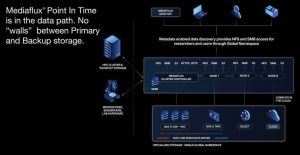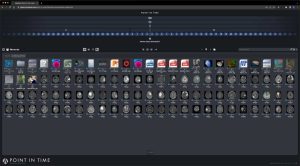Arcitecta Mediaflux Point in Time Backup and Recovery Approach Redefines Data Resilience at Scale
Inline data fabric secures data at scale, rolls back ransomware and expedites DR.
This is a Press Release edited by StorageNewsletter.com on December 16, 2022 at 2:01 pmArcitecta Pty Ltd. unveiled Mediaflux Point in Time, a backup and recovery approach that redefines data resilience at scale.
Click to enlarge
Powered by the company’s Mediaflux data fabric, Point in Time offers metadata-based data protection that secures data at scale, expedites DR, and eliminates the cost and business impact of lost data. It also provides a first line of defense against crypto locking with the ability to roll back ransomware attacks with its RPO and RTO.
“We are now in the Data Age, where data volumes quickly grow to billions and trillions of files. Terabytes of data are rapidly becoming petabytes to exabytes of data and beyond. Traditional methods of backing up data are unviable at those scales,” said Jason Lohrey, founder and CTO. “Organizations need a new approach to backup and recovery designed for the scale and complexity of today’s data demands. With Mediaflux Point in Time, we are redefining petabyte-scale data resilience and enabling enterprise organizations to eliminate the cost and business impact of lost data.”
Keeping large-scale data sets secure and resilient is a critical challenge. According to IDC, the amount of new data created, captured, replicated and consumed is expected to more than double in size from 2022 to 2026 (1), and Statista Research predicts the world’s collective data creation will reach more than 180ZB by 2025 (2). Traditional enterprise backup solutions are not designed to handle the complexity and scale of today’s data and do not meet the objective of zero data loss. Limitations on securing, locating and restoring data impede the business goal of continuous data availability, forcing business leaders to accept data loss. In addition, data growth makes organizations more vulnerable to cyberattacks such as ransomware crypto locking, which can devastate a business and impact it for years after the attack.
“Achieving data resilience at scale is increasingly critical in today’s data-driven world and requires a new approach. IT leaders must shift their focus from successful backups to successful recoveries. Beyond meeting data recovery time requirements, a truly scalable solution must enable effective self-service for its data users, automated data placement for optimal business results and enterprise-class data governance,” said Ken Clipperton, lead storage analyst, DCIG. “New approaches to data protection such as Arcitecta’s Point in Time provide a rapid recovery path to an operational state and make it possible for organizations to approach the ideal of zero RPO and zero RTO, even at scale.”
Mediaflux Point In Time GUI
Click to enlarge
New approach: Metadata-based continuous inline data protection for data resilience at scale
Mediaflux Point in Time is a new solution that eliminates the cost and business impact of lost or corrupted data and provides self-service data recovery. It allows users or IT administrators to go back to any point in time to recover needed files – even in the event of a cyberattack where files have been encrypted.
Designed for the scale and complexity of today’s data demands – billions of files and 1,000s of petabytes of data – the software-defined solution maximizes data resilience at scale and changes today’s broken backup paradigm. Point in Time integrates metadata-based, continuous inline data protection into the company’s Mediaflux data fabric, placing data protection in the data path as an integral part of the data fabric and file system. Every structural and data change is captured by Mediaflux Point in Time and recorded in Mediaflux’s performance database XODB.
Mediaflux Point in Time is for environments with billions of files or objects, petabytes or exabytes of data, and data that is spread across multiple storage systems and clouds. It virtualizes the existing storage infrastructure to provide CDP and presents as NFS or SMB (both protocols can be used concurrently on the same data), in addition to a host of other protocols, including sFTP, DICOM, S3.
It redefines resilient enterprise storage – the convergence of storage and data resilience in one system.
Benefits of Mediaflux Point in Time include:
- Data security and resilience at scale. Provides fast data recovery and zero data loss. Every structural and data change is captured and recorded in Mediaflux’s database XODB. By uniting the file system and the power of XODB, it provides inline data protection that actively records every significant change in real time for every file.
- Inline approach to CDP. Makes it possible to achieve continuity of service at scale with the ability to instantly unwind the file system to appear as it was at the selected point in time before the data corruption, hardware failure or malicious event. It enables the complete and immediate recovery of data – an RTO of zero – and virtually no downtime with an RPO near zero, typically within milliseconds.
- Roll back ransomware attacks. Provides the first line of defense vs. corporate loss and protection vs. criminals holding a business and its data hostage. Real-time recording of changes occurs, ensuring that the enterprise is protected in the event of a ransomware attack. No decryption keys are needed as Mediaflux Point in Time can rewind to the point before the event and unwind the damage in, at most, minutes – rather than days, weeks or more.
- Expedited data recovery. Users can interactively find and recover what they need. Every vital file change is recorded throughout all time and instantly accessible so end-users can find and recover data quickly with the click of a button. By scrolling a time-slider, users can roll back the entire file system structure to a point before the loss occurred. As they do so, they can see all files at all points in time, from the past to the present.
- ‘Do It Yourself’ data search and recovery. A GUI enables users to easily find and access their data, eliminating the need for IT intervention. Users can connect via their standard credentials to access a single, global namespace and find their data. Using the solution’s powerful, easy-to-use wildcard searches, users can find files in milliseconds, no matter when and where they existed – even when the search includes billions of files or more.
“The fundamental concepts of backup and recovery have changed little in the past 30 years, and older concepts that are now truisms have becoming limiting factors leading to unnecessarily long recovery times and excessive data loss in an era of petabyte data,” said Phil Goodwin, research VP, IDC. “With Mediaflux Point in Time, Arcitecta aims to break the current backup and recovery paradigm and redefine data resilience at scale with a fresh approach to minimizing the cost and business impact of lost data.”
Flexible storage and deployment options
Mediaflux Point in Time works with any storage type – unifying disparate storage (disk, object, tape, cloud) under a single namespace and a single mount-point or share. It can dynamically add or remove storage to match changing needs and mix technologies of different types from different vendors at any time to reduce cost and maximize resilience objectives. It can run on dedicated hardware, virtual machines, containers, cloud infrastructure or any combination. It supports multi-node scaling to match an organization or user’s performance requirements and can span hybrid on-premises and cloud deployments.
“Organizations need to reduce the risk of critical data loss and minimize impact from downtime, outages, data breaches and natural disasters. Data resiliency also prevents downtime when performing upgrades, data migration and planned maintenance,” said Stephen Park, senior storage and systems administrator, Murdoch Children’s Research Institute.
Mediaflux Point in Time is available as a component of the Mediaflux platform.
(1) IDC, Global Datasphere 2022-2026 Forecast, Doc #US49018922, May 2022
(2) Statista Research Department, Amount of data created, consumed, and stored 2010-2020, with forecasts to 2025, September 2022.
















 Subscribe to our free daily newsletter
Subscribe to our free daily newsletter


